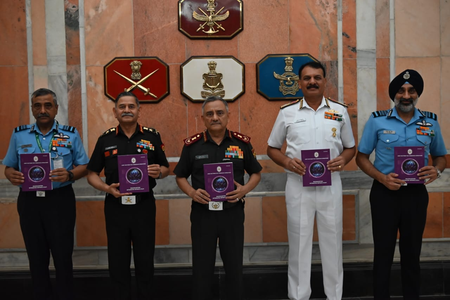
New Delhi, Aug 7 (IANS) Chief of Defence Staff (CDS) General Anil Chauhan on Thursday released the declassified versions of the Joint Doctrines for Cyberspace Operations and Amphibious Operations, underscoring the country’s commitment to enhance visibility, accessibility and wider dissemination of joint war-fighting concepts.
Releasing the document during the Chiefs of Staff Committee meeting, the CDS said that the doctrines will provide stakeholders and policy makers with a common lexicon and guidelines for effective planning and smooth execution of joint military operations.
The Joint Doctrine for Cyberspace Operations outlines a unified approach to defend national cyberspace interests, integrating offensive and defensive cyber capabilities and enabling synchronised operations across the three Services, said a statement.
It emphasises threat-informed planning, resilience building, real-time intelligence integration and development of joint cyber capabilities.
The Joint Doctrine for Amphibious Operations defines the framework for planning and executing amphibious operations by integrating maritime, air and land forces. It stresses interoperability, rapid response capability and joint force application to influence operations ashore.
The CDS has initiated development of numerous new doctrines/primers covering contemporary as well as niche areas of war-fighting, such as Military Space Operations, Special Forces Operations, Airborne/Heliborne Operations, Integrated Logistics, and Multi-Domain Operations.
Earlier this week, the Indian Army joined hands with the Indian Institute of Technology (IIT) Madras to establish ‘Agnishodh’, the Indian Army Research Cell (IARC) on the IIT Madras campus.
The research facility was formally inaugurated by General Upendra Dwivedi, Chief of the Army Staff (COAS), during his two-day visit to Chennai.
The initiative is part of the Indian Army’s broader transformation framework, guided by the Five Pillars of Transformation articulated by the COAS. Agnishodh specifically advances one of the pillars, Modernisation and Technology Infusion and represents the Indian Army’s drive to seamlessly integrate academic research with real-time operational applications.
Addressing a gathering at IIT Madras on the theme “Operation Sindoor – A New Chapter in India’s Fight Against Terrorism,” General Upendra Dwivedi described the operation as a landmark, intelligence-driven response that redefined India’s counter-terrorism doctrine.
He noted that the 88-hour operation was unprecedented in scale, range, depth, and strategic impact, and was executed across the DIME spectrum.
Highlighting the evolving nature of warfare, he underscored that the Indian Armed Forces are prepared for fifth-generation conflicts driven by non-contact warfare, strategic tempo, and psychological dominance.
Emphasising the Indian Army’s commitment to self-reliance under “Swadeshikaran Se Sashaktikaran,” he outlined key collaborations under national technology missions such as INDIAai, Chip-to-Startup, and Project QuILA, with MCTE Mhow as a strategic partner.
–IANS
rch/dan



